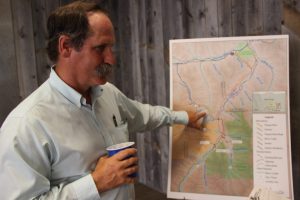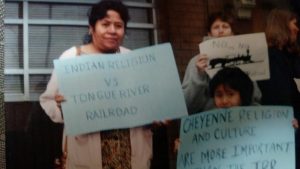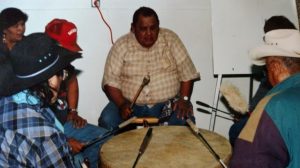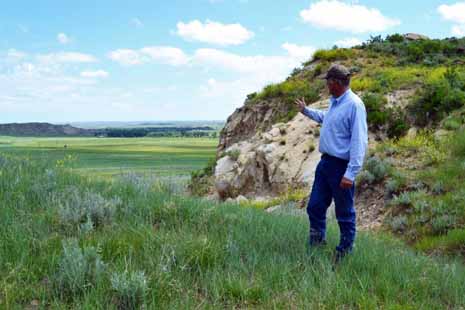The epic battle to defeat the Tongue River Railroad and what we can learn from it today
Quite a few folks associate Northern Plains Resource Council with the Tongue River Railroad. It’s a huge part of our history – Northern Plains has been around for 44 years and we fought the damned railroad for 37 of those years. To me, the story is interesting. It has a lot of characters – the heroes and heroines, many villains, cultural diversity, greed, trickery but in the end the good guys won. Many people ask us how we won and this is my version of that story.
I wanted to share this story now nearly 9 months after the monster died to give some hope and inspiration to so many of us who continue to fight for clean water, clean air, fairness and the right to peacefully enjoy your home. A modern day David and Goliath battle – it was not won easily or quickly but in the end, we did win – one of a small handful of railroad permits denied in American history. And given some of the big new battles we face, it’s important to take solace in long fights and long odds that paid off. Because if we learned anything, it’s that determined citizens working together can win unwinnable fights.
From that day on
The earliest records we have in the Northern Plains office that say the words “Tongue River Railroad” date back to 1979. From that day on, many of the people in the Tongue River Valley were alarmed and decided to assemble and fight it. From that day on, this ill-fated railroad took many shapes, impacted different people and ultimately died officially on April 24, 2016 when the federal agency that gives out permits for railroads finally denied their permit.
It was never alive but we killed it any way

The railroad was a creature that was never fully alive nor dead. No shovel of dirt was moved, no rail was laid to create the railroad. The only real beneficiary of this railroad was its promoter – Mike Gustafson who made millions just for selling his idea to a revolving door of investors.
It makes me mad that this speculative idea caused so much anxiety and expense for our region. With the threat of a railroad running through our places, it didn’t make sense for ranchers to put up fences or irrigation that would be ripped up and ruined with a railroad. It froze dozens of ranch businesses in place. The value of our property was low just with the threat of it. The time, money and energy it took from everyone who fought that railroad are hard to add up.
We used a combination of strategies:
Local organizing, public education, lobbying, discouraging investors, lawsuits, administrative interventions, research – we used every handle we could think of.
- We showed it was a bad deal – From economic and engineering studies to publications and community meetings, we highlighted what a poor investment this was for businesses, taxpayers, and investors. Even Warren Buffet can make a bad investment sometimes.
- We locals kept resisting it – I can’t tell you how many BBQ potluck fundraisers we held, house meetings, house parties, public presentations letters to the editor and comments! Comments! Comments! that we gathered over all those years.
- We kept up the public education drum – we did fact sheets, guest editorials, tried to get reporters interested, made videos, and produced and mailed newsletters to people all over SE Montana. The phrase “Tongue River Railroad” is well known and I’d say that we had a lot to do with that.
- We sought friends that had a mutual self interest in it. The changing routes of the railroad over time also changed who was about to get harmed by it. I put together this little grid to show how that changed. But we had no qualms approaching anyone whose self-interest was to not have that railroad built. I will say that the one constant ally we had all those years were the Northern Cheyenne. Sometimes it was the tribal council officially and most of time it was the people who lived near to the river who steadfastly opposed the railroad. Their work made so much difference.
- We played the legal/technical game – We were a party in official proceedings (I can tell you, it wasn’t that kind of party) before the federal agency that determined whether that railroad could be built. We had lawyers and expensive experts and we went to Washington, D.C. to visit with agency people hoping they’d exercise some logic as well as compassion. In the beginning of this fight the agency was the Interstate Commerce Commission but then in the Clinton Administration it became the Surface Transportation Board. We sued the STB in 1997 for using information that in some cases was four decades old and we won in 2007 – 10 years later! When we won, the Tongue River Railroad had to start their application all over again.
| TRR versions | TRR I | TRR II | TRR version III | TRR version IV |
| Dates | 1979-1986 | 1991 – 2007 | 2007-2012 | 2012-2016 |
| Route | Miles City to Ashland | Miles City to Decker | Miles City to Decker with less steep route | Otter Creek to Colstrip |
| Allies | Tongue River Valley Ranchers and Northern Cheyenne | Ranchers, Northern Cheyenne, four railroad unions, two coal mine unions, Cities of Forsyth, Sheridan and Hardin | Ranchers, Northern Cheyenne, four railroad unions, two coal mine unions, Cities of Forsyth, Sheridan and Hardin | Ranchers, Northern Cheyenne, MEIC, the Amish, a host of national environmental organizations, downrail cities and towns |
| Main issues | Would mean more coal mining, eminent domain/condemnation, disruption of ranching, fires, weeds, derailments | Eminent domain/condemnation, disruption of ranching, fires, weeds, derailments, loss of railroad jobs from cut-off, loss of mining jobs by making Wyoming mines more competitive | Eminent domain/condemnation, disruption of ranching, fires, weeds, derailments loss of railroad jobs from cut-off, loss of mining jobs by making Wyoming mines more competitive | Would mean more coal mining, eminent domain/condemnation, disruption of ranching, fires, weeds, climate change |


Persistence Alone is Omnipotent
If there was a silver bullet in this fight it was just sheer gumption to play the long game. Northern Plains fought it for 37 years, never once giving up on it despite many claims that it was just about to be built. We outlasted the bastards.
I would like to thank each and every one of you who made a phone call or submitted a comment or contributed money or testified to stop the Tongue River Railroad. It all made a difference!
Looking forward
Congress and the President have both taken decisive action in recent weeks to undermine protections that safeguard our land, air, and water. Many of us are waiting for things to get even bleaker, and in times like this, it can be hard to stay positive. But looking out from my front door and driving my pastures, I have hope. My wife and I grew up in eastern Montana, like so many of our neighbors, and it’s where we’ve raised our kids. We love it here, and we’ll fight to defend it.
As new threats and proposals come and go, we’re still here. And we’ve learned that that vigilance, care, and passion mean everything.
Stay strong. Stay fighting.
By Mark Fix.
Sign up for WORC blogs
WORC will send you a notice of new blog posts. You can sign up here.

